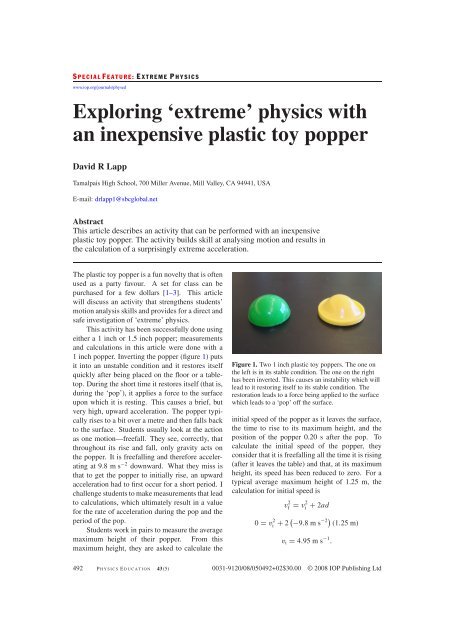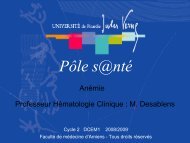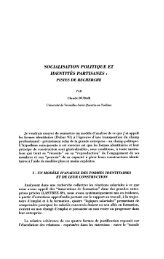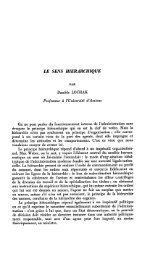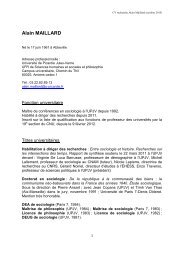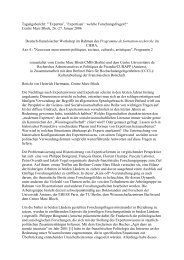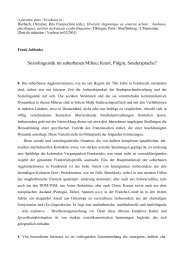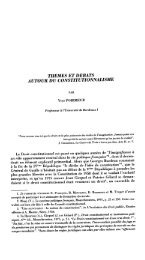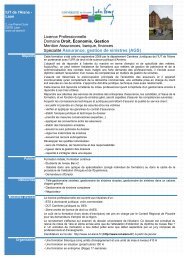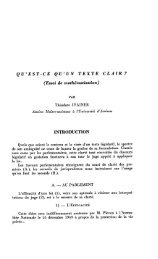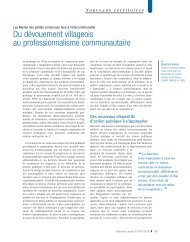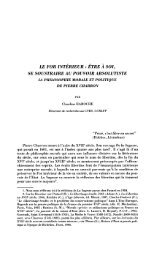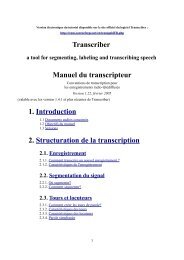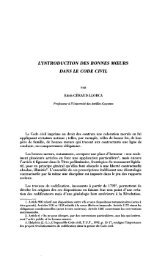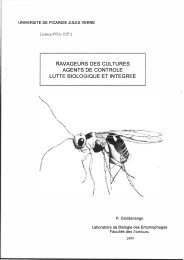Exploring `extreme' physics with an inexpensive plastic toy popper
Exploring `extreme' physics with an inexpensive plastic toy popper
Exploring `extreme' physics with an inexpensive plastic toy popper
Create successful ePaper yourself
Turn your PDF publications into a flip-book with our unique Google optimized e-Paper software.
S PECIALF EATURE: E XTREME P HYSICS<br />
www.iop.org/journals/physed<br />
<strong>Exploring</strong> ‘extreme’ <strong>physics</strong> <strong>with</strong><br />
<strong>an</strong> <strong>inexpensive</strong> <strong>plastic</strong> <strong>toy</strong> <strong>popper</strong><br />
David R Lapp<br />
Tamalpais High School, 700 Miller Avenue, Mill Valley, CA 94941, USA<br />
E-mail: drlapp1@sbcglobal.net<br />
Abstract<br />
This article describes <strong>an</strong> activity that c<strong>an</strong> be performed <strong>with</strong> <strong>an</strong> <strong>inexpensive</strong><br />
<strong>plastic</strong> <strong>toy</strong> <strong>popper</strong>. The activity builds skill at <strong>an</strong>alysing motion <strong>an</strong>d results in<br />
the calculation of a surprisingly extreme acceleration.<br />
The <strong>plastic</strong> <strong>toy</strong> <strong>popper</strong> is a fun novelty that is often<br />
used as a party favour. A set for class c<strong>an</strong> be<br />
purchased for a few dollars [1–3]. This article<br />
will discuss <strong>an</strong> activity that strengthens students’<br />
motion <strong>an</strong>alysis skills <strong>an</strong>d provides for a direct <strong>an</strong>d<br />
safe investigation of ‘extreme’ <strong>physics</strong>.<br />
This activity has been successfully done using<br />
either a 1 inch or 1.5 inch <strong>popper</strong>; measurements<br />
<strong>an</strong>d calculations in this article were done <strong>with</strong> a<br />
1 inch <strong>popper</strong>. Inverting the <strong>popper</strong> (figure 1) puts<br />
it into <strong>an</strong> unstable condition <strong>an</strong>d it restores itself<br />
quickly after being placed on the floor or a tabletop.<br />
During the short time it restores itself (that is,<br />
during the ‘pop’), it applies a force to the surface<br />
upon which it is resting. This causes a brief, but<br />
very high, upward acceleration. The <strong>popper</strong> typically<br />
rises to a bit over a metre <strong>an</strong>d then falls back<br />
to the surface. Students usually look at the action<br />
as one motion—freefall. They see, correctly, that<br />
throughout its rise <strong>an</strong>d fall, only gravity acts on<br />
the <strong>popper</strong>. It is freefalling <strong>an</strong>d therefore accelerating<br />
at 9.8 m s −2 downward. What they miss is<br />
that to get the <strong>popper</strong> to initially rise, <strong>an</strong> upward<br />
acceleration had to first occur for a short period. I<br />
challenge students to make measurements that lead<br />
to calculations, which ultimately result in a value<br />
for the rate of acceleration during the pop <strong>an</strong>d the<br />
period of the pop.<br />
Students work in pairs to measure the average<br />
maximum height of their <strong>popper</strong>. From this<br />
maximum height, they are asked to calculate the<br />
Figure 1. Two 1 inch <strong>plastic</strong> <strong>toy</strong> <strong>popper</strong>s. The one on<br />
the left is in its stable condition. The one on the right<br />
has been inverted. This causes <strong>an</strong> instability which will<br />
lead to it restoring itself to its stable condition. The<br />
restoration leads to a force being applied to the surface<br />
which leads to a ‘pop’ off the surface.<br />
initial speed of the <strong>popper</strong> as it leaves the surface,<br />
the time to rise to its maximum height, <strong>an</strong>d the<br />
position of the <strong>popper</strong> 0.20 s after the pop. To<br />
calculate the initial speed of the <strong>popper</strong>, they<br />
consider that it is freefalling all the time it is rising<br />
(after it leaves the table) <strong>an</strong>d that, at its maximum<br />
height, its speed has been reduced to zero. For a<br />
typical average maximum height of 1.25 m, the<br />
calculation for initial speed is<br />
v 2 f = v2 i<br />
+ 2ad<br />
0 = v 2 i + 2 −9.8ms −2 (1.25 m)<br />
vi = 4.95 m s −1 .<br />
492 P HYSICS E DUCATION 43 (5) 0031-9120/08/050492+02$30.00 © 2008 IOP Publishing Ltd
The calculation for the time to rise to its maximum<br />
height is<br />
a = vf − vi<br />
t<br />
−9.8ms −2 0 − 4.95 m s−1<br />
=<br />
t<br />
t = 0.505 s.<br />
The calculation for the position of the <strong>popper</strong> after<br />
0.20 s is<br />
d = vit + 1<br />
2 at2<br />
d =(4.95 m s −1 )(0.20 s)+ 1<br />
2 (−9.8ms−2 )(0.20 s) 2<br />
d = 0.79 m.<br />
The preceding calculations are good practice<br />
in using various kinematics equations to <strong>an</strong>alyse<br />
motion. Most students are surprised at how<br />
much information c<strong>an</strong> be gle<strong>an</strong>ed from making<br />
only a measurement of the maximum height of<br />
the <strong>popper</strong>. However, the biggest surprise for<br />
students is the magnitude of acceleration for the<br />
<strong>popper</strong> during the pop. As the <strong>popper</strong> restores<br />
itself, the force it exerts against the surface acts<br />
over a dist<strong>an</strong>ce approximately equal to its radius<br />
(1.25 cm). The acceleration of the <strong>popper</strong> over this<br />
short dist<strong>an</strong>ce is found using:<br />
v 2 f = v2 i<br />
+ 2ad<br />
4.95 m s −1 2 = 0 + 2a (0.0125 m)<br />
a = 980 m s −2 .<br />
Finally, students calculate the time of the pop:<br />
a = vf − vi<br />
t<br />
980 m s −2 = 4.95 m s−1 − 0<br />
t<br />
t = 0.005 05 s.<br />
My students have been encouraged to judge<br />
whether a particular result seems reasonable. Consequently,<br />
they frequently question the magnitude<br />
of the acceleration of the <strong>toy</strong> <strong>popper</strong>. They are<br />
impressed that they c<strong>an</strong> calculate such a high acceleration<br />
from the simple data they have collected.<br />
This acceleration of two orders of magnitude<br />
above the freefall acceleration qualifies as<br />
<strong>Exploring</strong> ‘extreme’ <strong>physics</strong> <strong>with</strong> <strong>an</strong> <strong>inexpensive</strong> <strong>plastic</strong> <strong>toy</strong> <strong>popper</strong><br />
‘extreme’ <strong>physics</strong>. The calculation of the very<br />
small increment of time for the pop also gives students<br />
pause when they consider that the ability to<br />
do this calculation was fully the result of their measurement<br />
of something as simple as the maximum<br />
height of the <strong>popper</strong>.<br />
Analysing the motion of the <strong>toy</strong> <strong>popper</strong>s is a<br />
fun activity for students. They enjoy the action<br />
of the <strong>popper</strong>s <strong>an</strong>d are impressed <strong>with</strong> the high<br />
acceleration <strong>an</strong>d very short time they are able to<br />
calculate. Those who finish a bit earlier th<strong>an</strong> the<br />
rest invariably continue to play <strong>with</strong> their <strong>popper</strong>s<br />
<strong>an</strong>d will often discover that the <strong>popper</strong> goes far<br />
higher if launched from the tip of a finger rather<br />
th<strong>an</strong> a flat surface. The first time I used this<br />
activity, a student discovered this <strong>an</strong>d asked me<br />
about it. I realised that when launched from<br />
the tip of the finger, the force applied during<br />
the restoration of the <strong>popper</strong> acts over a greater<br />
dist<strong>an</strong>ce. When the <strong>popper</strong> rests on a flat surface,<br />
the force applied to that surface begins when the<br />
<strong>popper</strong> is halfway through its restoration, but when<br />
it rests on a fingertip, the force is applied at the<br />
beginning of the restoration. This gives twice the<br />
time <strong>an</strong>d therefore twice the initial speed. Asking<br />
students to explain why the <strong>popper</strong>s rise to a higher<br />
maximum altitude when launched from a fingertip<br />
gets them to think more deeply about the <strong>physics</strong><br />
of the <strong>popper</strong>. I have since included this question<br />
as <strong>an</strong> extension to the calculations in the activity.<br />
The <strong>plastic</strong> <strong>popper</strong> gives students <strong>an</strong> opportunity<br />
to <strong>an</strong>alyse the <strong>physics</strong> of a simple <strong>toy</strong>. Toy<br />
<strong>popper</strong>s c<strong>an</strong> also provide teachers <strong>with</strong> <strong>an</strong> <strong>inexpensive</strong><br />
activity that gives students practice at<br />
<strong>an</strong>alysing motion as well as safe <strong>an</strong>d direct access<br />
to extreme <strong>physics</strong>.<br />
Received 21 June 2008<br />
doi:10.1088/0031-9120/43/5/004<br />
References<br />
[1] www.windycitynovelties.com/EPaysoft/Cart/<br />
product.asp?ITEM ID=6495&CatID=0<br />
[2] www.centurynovelty.com/detail 306 209-231.html<br />
[3] www.craftpacks.co.uk/#prod1725<br />
David Lapp has 22 years of high school<br />
<strong>physics</strong> teaching experience. The last 18<br />
years he has taught at Tamalpais High<br />
School in Mill Valley, California. He is<br />
also <strong>an</strong> occasional lecturer in the<br />
Department of Physics <strong>an</strong>d Astronomy at<br />
Sonoma State University. His interests<br />
are in <strong>physics</strong> education <strong>an</strong>d specifically<br />
in developing methods for making<br />
<strong>physics</strong> accessible to all students.<br />
September 2008 P HYSICS E DUCATION 493


